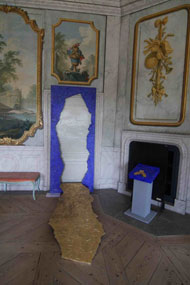Art affects most people, as an incentive, communication or simply a beautiful emotional experience. The broad conception of visual arts assumes that art is indeed something beautiful. Art can bring a range of emotions: joy, sorrow, hope, despair to name just a few. In contemporary art, the viewer can become uniquely confused, provoked and even be persuaded to find themselves facing old issues which have lain unresolved. One can see the art not only in one or in a few languages but as a dialogue between the artist and the viewer. It is a language that bridges the spiritual and the secular, the poetic world and the everyday life, the gentle meditative state with today’s increasingly hectic reality. This art pushes through new boundaries, it is no longer just about paintings and sculptures, the experience itself can become an art form. It may even be difficult to determine if art is art! The artwork here becomes less an exhibition, ornament or object more a challenge to the conventional idea of what art is! With the exhibition BEAUTIFUL, you are invited to an additional way to approach art. Our desire is that it will arouse your curiosity, not only for art but also to the historical process. The exhibition brings to life and convey the historical heritage, while the visitor gets a new and artistic experience. The exhibition is a series of installation/artwork for in- and outdoor placement showing human needs of beauty in historic perspective with new works by Ludmila Pawlowska. The exhibition is designed as a dialogue where one can imagine how the artist talks over the centuries, questioning and challenging each other as if they were all present in the same room at the same time. On a boundless and experimental ways is the artist inspired by cultural heritage and contemporary life at the same time. Exhibit space becomes a portal to another time or rather a desire for a different time and existence.
Beauty is highly ambivalent term in today´s discussions about art. For many artists and critics, the notion of beauty is anachronistic – it almost seems to be a taboo. It recalls the aesthetic debates of the 18th and 19th centuries, and evokes the idea of an artistic ideal, of norms and rules, which are rooted in Antiquity and in the Renaissance. The sheer mention of beauty in a discussion about art can be a provocation, because it immediately raises the question of authority, namely: who can decide what is beautiful and what is not? If we, rather naively, understand beauty is something that immediately strike us by its appearance, that we never get tire of looking at, we have sympathy for and even identity with, and that prompts us to take a fresh look at our surroundings, then we should perhaps, call it – BEAUTIFUL!
Ludmila Pawlowska describes her thoughts about the exhibition:
The works that I propose is, both sculpture and painting, “already exists” there as I can see. I see them as linked to historic places in a timeless way…. When you stroll through the rooms of historic places and its Gardens, you feel the energy of a setting that gravitates between reality and dreams, the everyday and magic, the festive and the tragic, its spirituality. How would the life of this place look if this exuberant and grandiose universe was transferred to our period?
This is the exhibition about historical beauty …… However, it is not an exhibition about what it was – that is its historical causes, processes, and the final outcome – but a show about how I, as a contemporary artist and human being is influenced by its history and tradition. It shows the processes of perception, sensations and moods/feelings that interest me which has been in the past. For what I tried to reconstruct is not so much a sequence of events as an emotional world. The main theme of the exhibition is color experience in historical perspective (color symbolism) and how to use symbols as a visual language.
BEAUTIFUL – for your pleasure – enjoy!
Jan lech, Exhibition curator
